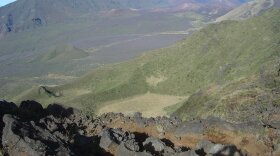
The very first telescope on Haleakal? was completed in 1958, and used for satellite tracking. Three years later, 18 acres of ceded land at the summit were set aside for astronomy, becoming the Haleakal? High Altitude Observatory Site with the University of Hawai‘i as owner/manager. Currently there are ten facilities on the mountain and another, a cutting edge solar telescope, is underway. HPR’s Noe Tanigawa reports on the controversy over its construction.

The sun is already hot here ten thousand feet in the air---clouds ring Haleakal? at the inversion layer about 3 thousand feet below us. Here at Haleakal? High Altitude Observatory, HO, construction is underway for the Daniel K Inouye solar telescope, or DKIST.
Brett Simison, the DKIST construction manager, says the structure of the telescope is 90% to its full height already, even though a lawsuit challenging its validity remains undecided in Hawai‘i’s Supreme Court.
Kahele Dukelow, of UH Maui and fellow cultural practitioner, Trinette Furtado were among the estimated 200 who held a vigil at the DKIST baseyard recently, preventing the delivery of construction materials. Haleakal? is a sacred mountain to Hawaiians, a storied place rich with history and legends. Some feel it has already been desecrated by the establishment of the University of Hawai‘i’s Science City with seven observatories already in operation. The group, Kilakila o Haleakal? has been protesting the DKIST for over ten years. Now that the case is before the Hawai‘i Supreme Court.
Joe Mcmullin is DKIST’s project manager. He’s just flown in for about a week to facilitate next steps in the construction. Mcmullin says a ship in a bottle analogy fits here because once the structure is complete, they’ll begin inserting the telescope
In December 2010, the state Board of Land and Natural Resources issued a permit allowing construction to begin. That permit was revoked, because it was issued before a required contested case hearing. That hearing was held but the hearing officer was disqualified due to ex parte communication from a representative of Senator Daniel Inouye. In 2012, a second hearing officer recommended granting the permit .
McMullin: “We did not begin construction until after that contested case had been cleared and the second permit issued. And at that point we had fulfilled all the state and federal obligations and were allowed to begin construction.”
The DKIST broke ground in December 2012.
Dukelow says she and other native Hawaiians have been consistent with their message since the beginning of the consultative process for the telescope in the early 2000’s. “The courts, and the whole legal process, we always lose. It’s not set up for us to win. It’s just set up for a process so they can say we consulted, there’s the mitigation, we move on. And we’re saying, nope.”
An appeal challenging the second BLNR permit is now before the Hawai‘i supreme court, where oral arguments were held in April. The recorded hearing is fascinating. Attorney Lisa Munger represents the University of Hawai‘i which is proposing the DKIST project. David Frankel of the Native Hawaiian Legal Corporation represents Kilakila o Haleakala, the appellant. At one point Chief Justice Mark Rechtenwald asks how the environmental impact statement’s findings relate to granting the permit. He questions how “we get from an EIS that says there’s a major impact, to an order of the Board that says there’s no substantial impact?”
In response to Justice Rechtenwald’s question regarding the concept of cumulative impact, UH attorney Lisa Munger asserts the EIS is informational only and does record objections to the DKIST project, as well as other facilities on Haleakal? .
Records show ongoing meetings. In 2008, for example, National Science Foundation representatives met with representatives of OHA, Kilakila o Haleakal?, the state Historic Preservation office, the National Park Service, and others for input before proposing the solar telescope. Minutes show native Hawaiian attendees repeatedly voiced concern over not being heard.
David Kimo Frankel, attorney for Kilakila o Haleakal? says the issue is, what should be allowed on conservation land. Meanwhile, DKIST, the NPS, DLNR, UH and Maui police are consulting on next steps, after the recent protest vigil that stopped delivery of construction materials. Joe mcMullin
In the supreme court hearing, justices asked why mitigations arrived at after years of consultation do not satisfy the appellant . More on that in the next installment.
Get more information about the Daniel K. Inouye Solar Telescope .
Find out more about the position taken by Kilakila o Haleakal?
Hear the Hawai'i Supreme Court oral arguments from April 2, 2015





